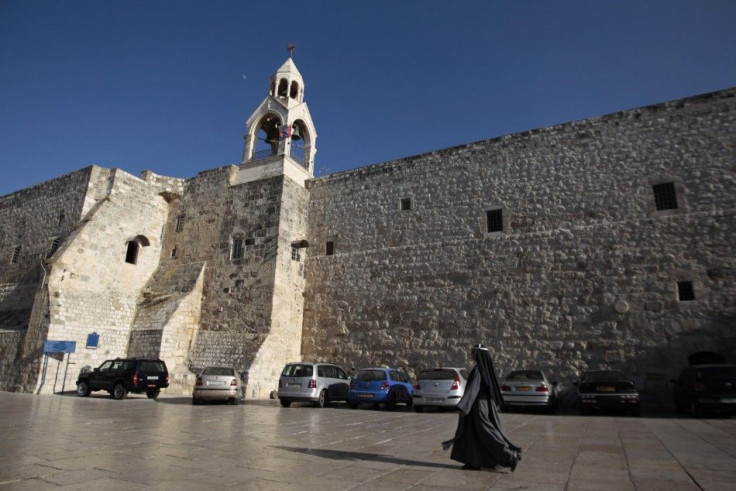A Christmas Tree In Bethlehem, Few Visitors In Jerusalem, Two Wars In The Holy Land

JERUSALEM -- On Saturday, Dec. 15, thousands of gleaming lights and ornaments were lit on the 15-meter (50 ft) tall Christmas tree overlooking Manger Square in Bethlehem, a stone's throw from the Grotto of the Nativity, where, according to Christian tradition, Jesus was born.
The lighting was the signal for Bethlehem's large Christian minority to get ready for the upcoming celebration in this city of 22,000.
The next morning, Palestinian youngsters took pictures in front of the huge tree, set against crystal-clear skies.
Excitement ran high as well among hundreds of tourists from all over the world, lining up to see the Grotto, at the bottom of a flight of stairs beneath the floor of the Christian Orthodox Basilica of the Nativity. The basilica, built in the 4th century AD, is considered to be the world's oldest continuously operating church, and it was recently chosen as a World Heritage Site by the United Nations' culture and education agency, UNESCO.
"I am happy, very happy,” said an Indonesian woman, one of the dozens of visitors packing the courtyard of Saint Catherine, the Catholic church inside the compound of the Nativity.
“It is a dream that comes true for me to be here, to see with my eyes the place where Jesus was born over 2,000 years ago.”
Another Indonesian pilgrim said, “Being a Christian, I feel that here really embodies our faith.”
The deeply religious atmosphere in Bethlehem goes hand in hand with the secular jumble of food stalls and souvenir shops dotting the streets leading up to Manger Square.
The climate is decidedly international. This holiday season, "we expect around 100,000 pilgrims in Bethlehem, many of them African workers coming from Israel,” said Raimondo, a Spanish-speaking Palestinian employee of Casanova, a restaurant and hotel next to the Church of the Nativity.
"The recent war in Gaza affected our business in November,” he said, referring to the latest confrontation between Israel and Hamas, “but it is not going to have consequences in the next weeks, as we have not got cancellations so far."
Israel's Ministry of Tourism says 2012 has been a record year, with 3.3 million visitors entering the country. A majority were Christian, and among those, Catholics dominated with 52 percent of visitors, while 21 percent were Protestant and 10 percent Orthodox (other Christian denominations accounted for the rest.) Another 75,000 tourists are expected to arrive during the Christmas period, one-third of them pilgrims.
Despite those positive figures, the mood is very different among shopkeepers in the Old City of Jerusalem, where Christmas decorations are scarce. Business is poor due to a shrinking number of visitors and customers; the flare-up of the conflict between Israeli and Palestinian radicals, and ailing European and American economies, conspired to keep many away from the city.
“People are not as many as before,” said shopkeeper Fuad Halloun.
“We want peace, we like peace, we want everybody to be free and to live in peace,” he said, sitting in front of his souvenir shop along the cobblestone alley leading to the Church of the Holy Sepulcher. The structure stands on the ground where Christians believe that Jesus was crucified and buried.
The Holy Sepulcher is among the sites of the Holy Land under the custody of the Franciscan order, which also oversees the Catholic communities scattered throughout the Middle East.
Inside the Franciscan's headquarters, known in Latin as the Custodia Terrae Sanctae, in the city's Christian quarter, three bespectacled artisans huddle over their workbenches, carving wooden crosses and rosaries for the pilgrims.
"The most awaited moment is the Midnight Mass in Bethlehem, but the crowds (that) do not have access to it enjoy usually the entry of the Latin Patriarch into the Church of the Nativity,” said one, who said he has spent the last 50 years working there.
Yet, feelings are mixed among the monks and nuns walking the Custody hallways. Besides the military confrontation last month between Palestinian militants in Gaza and the Israeli army, everybody here is concerned over their Order's brothers and sisters trapped in the other conflict next door: Syria’s ongoing civil war.
"Christmas raises great expectations here, but it always sees problems, since this never stops being a troubled land,” said Father Pierbattista Pizzaballa, the Italian monk who holds the office of Father Custodian of the Holy Land.
“People in Syria are frustrated and scared by the war, as they feel unsafe, and Christians are among them,” he said during a conversation inside the Church of All Nations (known also as Basilica of the Agony), located on the Mount of Olives, next to the Garden of Gethsemane.
After 21 months of war, with 40,000 deaths according to some estimates, millions of Syrians have either been displaced from their homes or become refugees outside the country, including almost one million Christians, according to the Custody.
To them, once again, Christmas season in the Holy Land will unfold against a backdrop of bombs, bullets and grief, instead of revelation and joy.
© Copyright IBTimes 2024. All rights reserved.





















